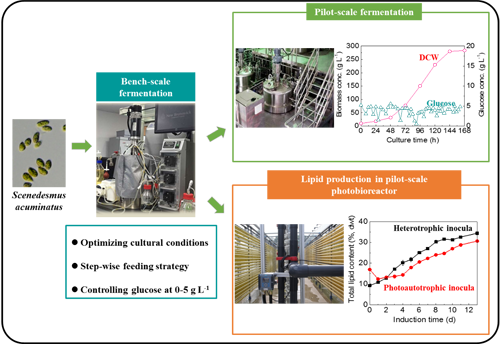[ Instrument Network Instrument Development ] Heterotrophic culture is a new type of microalgae biomass production method. Compared with traditional photoautotrophic culture, it has the advantages of high efficiency, high controllability and easy industrial production. However, compared to general industrial microorganisms (such as bacteria and yeast), the current biomass concentration of microalgae under heterotrophic culture conditions is still very low (<100 g/L), which also limits the technology. Industrial application. The development of stable and efficient microalgae high-density heterotrophic culture technology is a hot topic in the field of microalgae biotechnology.

Researchers from the Institute of Hydrobiology, Chinese Academy of Sciences, using a heterotrophic culture of S. cerevisiae as the research object, achieved ultra-high density of the algae through process optimization, especially the breakthrough of precise glucose concentration control. Culture - Under the conditions of laboratory and pilot fermenter amplification, the highest cell dry weight of Scenedesmus was 286 and 283.5 g/L, respectively, which is the highest concentration of microalgae culture biomass reported in the world, and is much higher than that. The highest biomass level of all known industrial microorganisms (bacteria and yeast).
The study also found that the oil production performance of heterotrophic algae cells as seeds in outdoor pilot scale photoreactors was significantly better than that of algal cells from photoautotrophic culture sources. Further technical and economic analysis showed that when the dry weight of cells under heterotrophic culture conditions reached a certain high concentration level (>200 g/L), the production cost of microalgae biomass was the same as that of the traditional runway pool, and only the pipeline photoreactor Cultivate one-fifth of the system. Therefore, microalgae ultra-high density heterotrophic culture technology has great commercial potential.
The research results were published online on October 15th in Biotechnology and Bioengineering, an international academic journal in bioengineering. The research was funded by the National Development and Investment Corporation, the Natural Science Foundation of Hubei Province, and the Key Program of the Chinese Academy of Sciences. It was completed by the Institute of Aquatic Sciences of the Chinese Academy of Sciences, the National Algae Center of the National Investment and Development Corporation, and Jinan University. The first author of the thesis is Jin Hu, Ph.D., assistant researcher of the Microalgae Biotechnology and Bioenergy Center of the Institute of Aquatic Sciences, and the research authors Han Danxiang and Hu Qiang.
It is reported that on the basis of this research, the research team has realized heterotrophic ultra-high density culture of various economic microalgae such as high-yield protein, β-1,3 glucan, astaxanthin and polyunsaturated fatty acids, which is currently under development. These functional microalgae product development work in the fields of feed, functional foods, etc. The breakthrough of high-density heterotrophic culture technology will greatly promote the application of microalgae as energy, food and feed raw materials, and inject new kinetic energy into the development of related industries.
Electrode is made up of ceramic body, electrode pin, with or without cable bracket and terminals.
Ceramic body: 95% Aluminum, Steatite with glazing or no glazed layer
Electrode pin: OCR25AL5, SUS310, SUS304
Cable: UL1332, UL1911, UL3573, UL3257
Bracket: SPCC, SUS304
Terminals: Various quick connection terminals are available
Advantage: Long life, Anti-high temperature, Corrosion resistance
Application: Gas cooker, Water heater, Gas oven, Gas boiler, Andiron, BBQ
Electrode
Ignition Electrode,Ceramic Electrode,Cooker Electrode,Gas Electrode
CHANGXING BENNENG GAS APPLIANCE CO.,LTD , https://www.benngas.com
